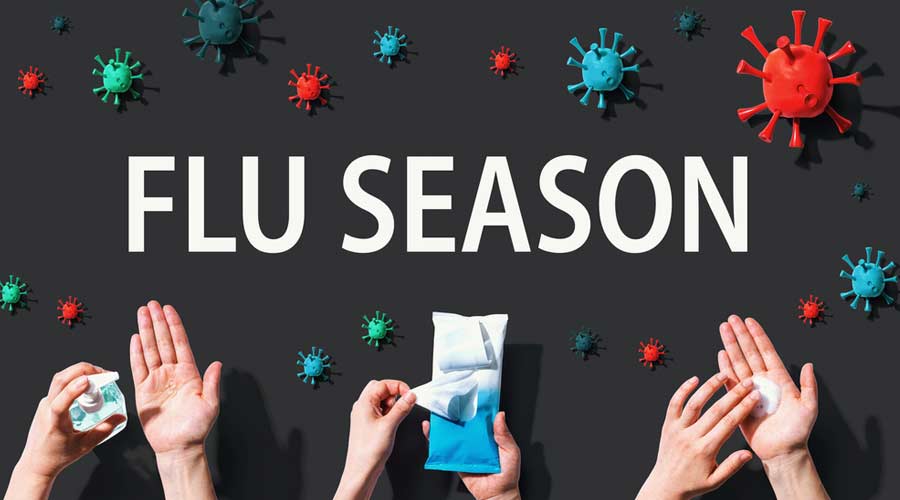
The 2022-23 flu season, marked by unprecedented unpredictability and a higher-than-usual volume of cases, offers businesses important learnings on how to protect their staff and patrons in the workplace, according to new analysis conducted by scientists and data experts from Reckitt's Lysol Pro Solutions and BlueDot.
Reckitt's Lysol Pro Solutions and BlueDot Inc. analyzed the spread and burden of flu in the U.S. during the current season compared to previous years. The analysis found the following:
The season has been unprecedented and unpredictable
• 72 percent of U.S. states observed a higher-than-usual volume of flu cases during the current season, compared to the mean burden of flu observed between 2015-2019.
• 90 percent of U.S. states reported an earlier-than-usual start to the current flu season, and the peak volume of cases occurred earlier than would be expected.
• Multiple-wave patterns from countries in the southern hemisphere such as Australia – often a predictor of the season in the U.S. because the seasons are inverted – indicate a potential emerging second wave later in the current season. A double-wave pattern was also observed in the U.S. in 2018-2019, driven by two different influenza A subtypes.
Combination of diseases has burdened the healthcare system
• The combined burden of flu with COVID-19 and respiratory syncytial virus (RSV) resulted in peak hospitalization rates greater than any period during the pandemic, with the exception of the Omicron wave (early 2022).
• A compounding factor adding to this burden has been the increase in invasive group A strep (iGAS) infections among children in the U.S., which is currently being investigated by the CDC.
"As anticipated, we've observed an unusually early start to the 2022-23 influenza season which has burdened our healthcare systems at an already vulnerable time," said Dr. Andrea Thomas, director, Epidemiology at BlueDot. "While flu cases are currently subsiding, we have observed that some countries in the southern hemisphere experienced a second wave approximately five to six months after the first peak in cases during their first substantial flu seasons since the pandemic began. These waves were driven by different flu strains. Given that most cases so far have been influenza A strains and there has been very little exposure to the flu over the last few years, it is possible that a second wave of flu could occur, potentially driven by influenza B.This underscores the need for businesses and citizens to remain active in preventative health measures, and it is not too late to obtain a flu vaccine if individuals have not already done so."
For operations teams that are responsible for the cleaning and maintenance of facilities, the following learnings can be applied to help protect staff and patrons:
• The typically predictable timings for flu season may no longer be accurate, reinforcing the need for a high-level of germ protection throughout the year.
• With the ongoing threat of COVID-19 and the surges in RSV and streptococcus A (strep A), this winter showed that flu is no longer the only respiratory virus threat in the workplace. Businesses should understand the difference between how these different viruses are transmitted and deploy effective prevention strategies that address spread through both surfaces and air.
• Cleaning teams should place an added focus on cleaning and disinfecting high-touch, high-traffic areas in business facilities, and the surfaces in those areas that are more prone to harboring germs, such as shared conference room tables and equipment.
"The current flu season has been a challenging and uncertain time for businesses — but the learnings from it can help reduce the burden of respiratory viruses this year, and beyond," says Dr. Julie McKinney, director of Research and Development at Reckitt's Lysol Pro Solutions. "In an environment where companies are facing widespread labor shortages and cost pressures, maintaining worker productivity and optimizing operational efficiencies are key priorities across the board. By keeping abreast of the ever-changing nature of how different respiratory viruses and bacteria can threaten the workplace, businesses can develop effective prevention strategies that use the right products, in the right areas, and at the right frequency to help protect their people, reduce worker sick days, and improve efficiency."

 The Down and Dirty on Cleaning in Virus Season
The Down and Dirty on Cleaning in Virus Season How Surfactant Use is Expanding in Commercial Cleaning
How Surfactant Use is Expanding in Commercial Cleaning